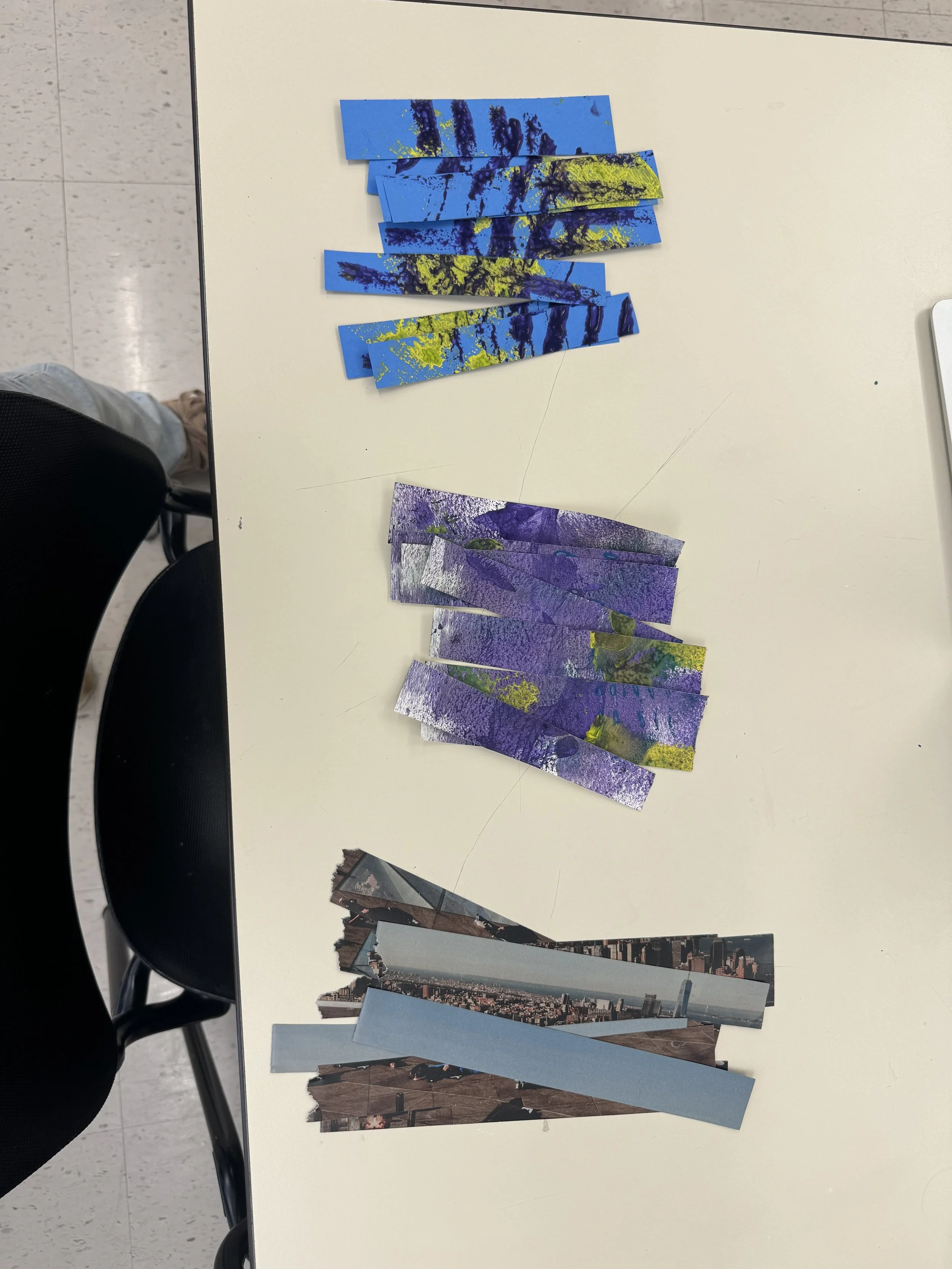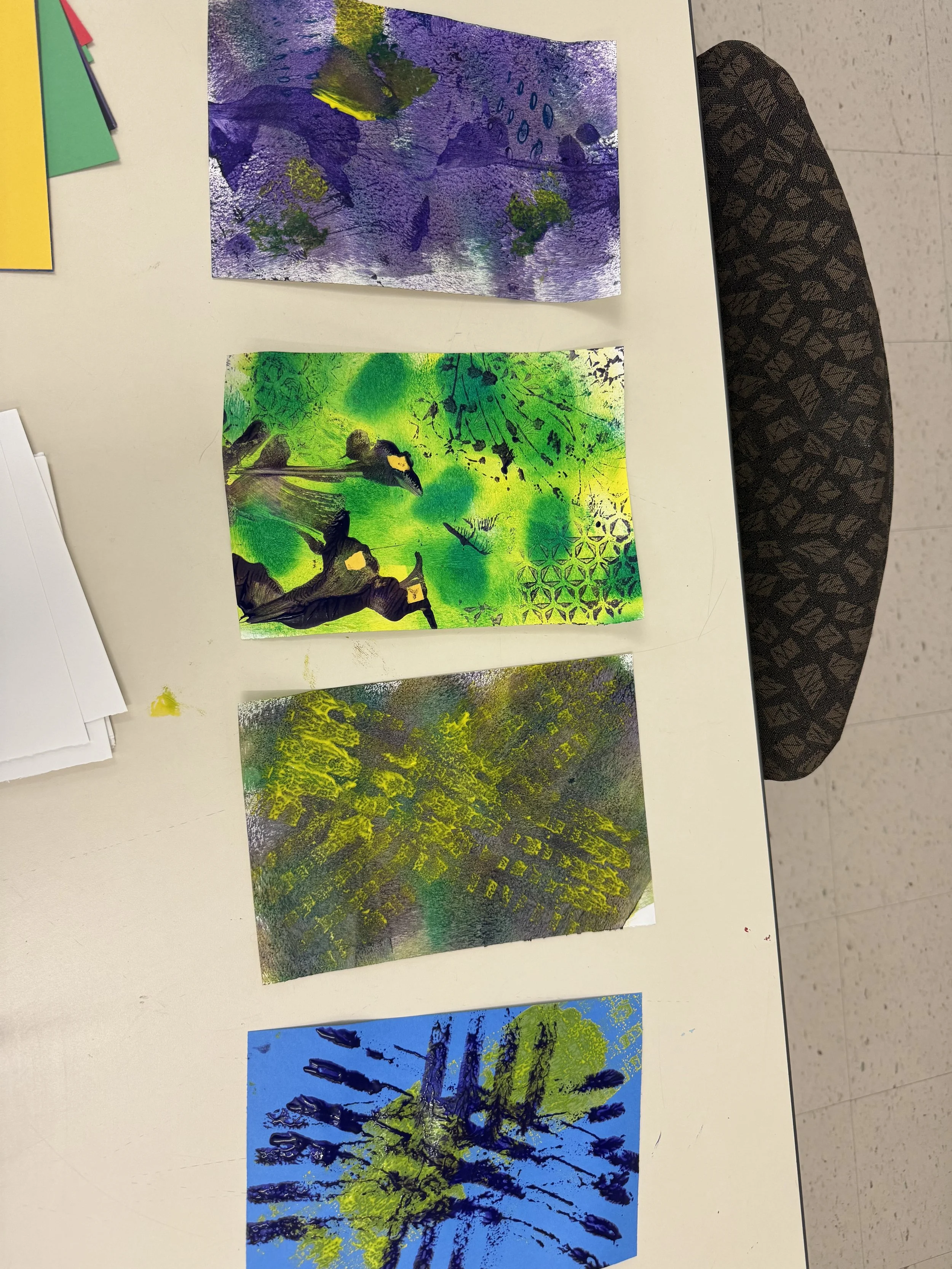Big Idea: Throughout times and across cultures civilizations have used weavings in varieties of ways.
Mixed Media Weavings
Grade: 3rd/4th
Time Allotment: 3-4 classes, 1 hour each
Key Concepts:
Weaving can be used as a form of expression
Weaving can be used in many different ways
There are a variety of materials that can be used to weave
EQ’s:
How can we show self expression through weaving?
How do we see weaving used in everyday life?
What materials can we use to make a weaving?
Lesson Summary/Rationale:
The students will learn the history and the basics of weaving and implement this into their pieces. The students will experiment with mixed media painting techniques on sheets of paper. The students will then cut the mixed media paintings they made into strips and weave them together to create a mixed media weaving. If some students would end up working quicker than others, they would have the option to add other media into their weaving or on top of their weaving.
Artist/Art investigation:
For a contemporary artist connection, the mixed media artist Lisa Goddard. She does mixed media art journaling working with fabrics and other found materials. She is currently gearing her work towards teaching workshops about mixed media weavings. She also has this ideology of the pieces and her work sharing untold stories. I would introduce her to the students by talking about her use of materials. She uses some unconventional paint and painting methods; she talks about her use of coffee and her combination of acrylic and ink. I would use this use of mediums to talk about the creation of the mixed media paintings the students would be making. I would then start to introduce her weavings to the students and have some discussions about what she did and her creation of them.
For a historical artist, Ancient Andean Weavings. These weavings show great use of texture and storytelling. They show other materials being put into the weaving and they also show visual storytelling.
National Standards:
VA:Cr2.1.4a: Explore and invent artmaking techniques and approaches
The students will be exploring mixed media techniques to create their sheets of mixed media paintings
Va:Re7.2.4a: Analyze components in visual imagery that convey messages
The students will analyze the artist investigation images and dive deeper into how visual imagery conveys messages
PA Standards:
9.4.3.D: Recognize choices made by artists regarding subject matter and themes communicate ideas through works in the arts and humanities
Students will investigate the artist investigation works and relate themes and ideas
9.1.3.D: Use knowledge of varied styles within each art form through a performance or exhibition of unique work
Each student will be demonstrating their individual works by creating and experimenting with their own art techniques
Interdisciplinary Connections:
History
How weaving have been used throughout history and in cultures
Objectives:
Knowledge: Students will demonstrate knowledge of the use of weaving throughout history and cultures by using learned techniques to create their own piece.
Skills: Students will demonstrate exploration of mixed media skills by creating mixed media paintings and weavings.
Dispositions: Students will work individual experiences into their pieces and show how visual imagery can convey a message.
Assessment:
The students will have the objectives of showing in progress work though each step with the instructor. students will also be given a rubric/checklist to keep them on track with what they need to get done (see end of document)
Knowledge of weaving and its background
Mixed media paintings
How visual imagery shares a story
Final weavings
Artist's statement
Instructional Procedures
Day 1
Motivation/Engagement:
How do we see weaving used in everyday life?
The students will be introduced to weaving and its background and be able to share knowledge on this topic. The students will also be introduced to the artist through a powerpoint presentation (see end of document) and be able to dive deeper into their thoughts on these artworks. They will be able to begin experimenting with mixed media techniques.
Development:
The students will start off by being introduced to weaving and the history of weavings. The students will then be introduced to the artist and dive deeper into her works. (Through a presentation)
They will then be introduced to some mixed media techniques and the exploration of techniques (through a demonstration). They will then be able to start exploring these techniques, depending on time allotted.
Closure: The students will be given the opportunity to be able to share their experiences with experimentation and any new techniques they might have discovered
Day 2
Motivation/Engagement:
The students will have this day to really explore art techniques and create the bulk of their mixed media pages
How can we use self expression in weaving?
Development: The students will be shown a variety of materials that will be out for them to explore with. They will then be given most of the time to explore with these materials to create their mixed media pages. During this time they will be instructed to think about a deeper meaning behind their weaving, through lived experiences, etc. For the students that might finish early or work faster than others, they will be able to start cutting their pieces into strips and thinking more about deeper meaning in the pieces.
Closure: the students will separate their pieces on a drying rack and clean up, making sure to think about a deeper meaning or where they want to go with their piece. They will have the opportunity to share this within groups after cleaning up.
Day 3
Motivation/Engagement:
During this day the students will be introduced to the cutting and weaving of their strips and be given more work time.
What materials can we use to make a weaving?
Development: The class will start out with a short demonstration of cutting and weaving the strips, they will be shown how to weave other materials into their pieces. The students will then be given work time to finish up any more of their paintings and start cutting and weaving their pieces. Adding the things that give their pieces deeper meaning.
Closure: The students will keep all of their pieces together and put them in an allotted spot. They will be instructed that the next class will be their final work time for this piece, they will have to think about making an artist's statement for the deeper meaning of the piece.
Day 4
Motivation/Engagement: The students will use this day to finish their pieces
What is an artist statement and what does it consist of?
Development: The students will have this day to finish their weaving and write an artist's statement for their piece (deeper meaning). They will then have the opportunity to share their pieces with a small group
Closure: The students will be split into small groups and share their pieces and artists statements
Preparation:
Teacher Research and Preparation:
Make sure to have mixed media supplies prepared
Instructional Resources:
See Images
Student Supplies:
Paint (Various types, watercolor, tempera)
Various replacements for paint (Tea, Coffee, Etc.)
Watercolor Paper
Various brushes and things to paint with
Scissors
Glue
Larger paper to glue weavings on to
Adaptations/Modifications:
For a student with Cerebral Palsy:
The student would have access to modified tools to use
Bingo daubers instead of paint
Sponges to paint and glue things down with
Sliding paper cutter instead of scissors
For a student with visual disabilities
Have a color coding system for the student so they know what colors they are using
Maybe implement more textures for the students
Textured paints
Textured painting materials
I don't think this student would be unable to weave or paint, I think it would be beneficial for the student to be able to differentiate textures when weaving and painting. This all depends on specific student needs.








